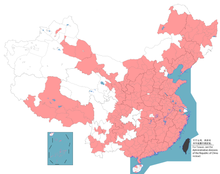
Back Ciudá-prefeutura de la República Popular China AST Градска префектура Bulgarian Ciutat-prefectura Catalan Městská prefektura Czech By på præfekturniveau Danish Bezirksfreie Stadt German Ciudad-prefectura de la República Popular China Spanish Ringkonna õigustega linn Estonian Prefektura mailako hiri Basque شهر در سطح ولایت Persian
This article has multiple issues. Please help improve it or discuss these issues on the talk page. (Learn how and when to remove these messages)
|
| Prefecture-level city Prefectural-level city | |||||||||||||||
|---|---|---|---|---|---|---|---|---|---|---|---|---|---|---|---|
 | |||||||||||||||
| Chinese name | |||||||||||||||
| Simplified Chinese | 地级市 | ||||||||||||||
| Traditional Chinese | 地級市 | ||||||||||||||
| Literal meaning | Regional-level city | ||||||||||||||
| |||||||||||||||
| Tibetan name | |||||||||||||||
| Tibetan | ས་ཁུལ་རིམ་པ་གྲོང་ཁྱེར། | ||||||||||||||
| |||||||||||||||
| Mongolian name | |||||||||||||||
| Mongolian Cyrillic | Дугаргийн энтэй хот | ||||||||||||||
| Mongolian script | ᠲᠣᠭᠣᠷᠢᠭ ᠤᠨ ᠡᠩ ᠲᠡᠢ ᠬᠣᠲᠠ | ||||||||||||||
| |||||||||||||||
| Uyghur name | |||||||||||||||
| Uyghur | ۋىلايەت دەرىجىلىك شەھەر | ||||||||||||||
| |||||||||||||||

| Administrative divisions of China |
|---|
|
History: before 1912, 1912–49, 1949–present Administrative division codes |
A prefecture-level city (Chinese: 地级市(地級市); pinyin: Dìjíshì) or prefectural city is an administrative division of the People's Republic of China (PRC), ranking below a province and above a county in China's administrative structure.
During the Republican era, many of China's prefectural cities were designated as counties as the country's second level division below a province. From 1949 to 1983, the official term was a province-administrated city (Chinese: 省辖市). Prefectural level cities form the second level of the administrative structure (alongside prefectures, leagues and autonomous prefectures). Administrative chiefs (mayors) of prefectural level cities generally have the same rank as a division chief (Chinese: 司长) of a national ministry. Since the 1980s, most former prefectures have been renamed into prefecture-level cities.
A prefectural level city is a "city" (Chinese: 市; pinyin: shì) and "prefecture" (Chinese: 地区; pinyin: dìqū) that have been merged into one consolidated and unified jurisdiction. As such it is simultaneously a city, which is a municipal entry with subordinate districts, and a prefecture with subordinate county-level cities and counties which is an administrative division of a province.
A prefectural level city is often not a "city" in the usual sense of the term (i.e., a large continuous urban settlement), but instead an administrative unit comprising, typically, a main central urban area (the core city, city as in the usual sense, usually with the same name as the prefectural level city) surrounded by rural areas, which together are divided into districts, and some surrounding counties or county-level cities governed by the prefecture-level city on behalf of the province, which all have their own urban areas surrounded by their own rural areas. The urban areas of the surrounding counties are usually smaller than the core urban area, and towns also form small urban areas scattered in the rural. The larger prefectural level cities span over 100 kilometres (62 mi).
Prefectural level cities nearly always contain multiple counties, county level cities, and other such sub-divisions. This results from the fact that the formerly predominant prefectures, which prefectural level cities have mostly replaced, were themselves large administrative units containing cities, smaller towns, and rural areas. To distinguish a prefectural level city from its actual urban area (city in the strict sense), the term shìqū (市区; "urban area"), is used.
The first prefectural level cities were created on 5 November 1983. Over the following two decades, prefectural level cities have come to replace the vast majority of Chinese prefectures; the process is still ongoing.
Most provinces are composed entirely or nearly entirely of prefectural level cities. Of the 22 provinces and five autonomous regions of the PRC, only nine provinces (Yunnan, Guizhou, Qinghai, Heilongjiang, Sichuan, Gansu, Jilin, Hubei, and Hunan) and three autonomous regions (Xinjiang, Tibet, and Inner Mongolia) have at least one or more second level or prefectural level divisions that are not prefectural level cities. In the case of the disputed Taiwan, it has six prefectural level cities, but these are governed separately by the Republic of China as their special municipalities.
Criteria that a prefecture must meet to become a prefectural level city:
- An urban centre with a non-rural population over 250,000
- gross output of value of industry of 200,000,000 RMB (US$32 million)
- the output of the tertiary sector supersedes that of the primary sector, contributing over 35% of the GDP[1]
Fifteen large prefectural level cities have been granted the status of sub-provincial city, which gives them much greater autonomy.
Shijiazhuang, Suzhou, and Zhengzhou are the largest prefectural level cities with populations approaching or exceeding some sub-provincial cities.
A sub-prefecture-level city is a county-level city with powers approaching those of prefectural level cities.
- ^ "China's Political System". Archived from the original on 2009-03-27. Retrieved 2009-09-22.